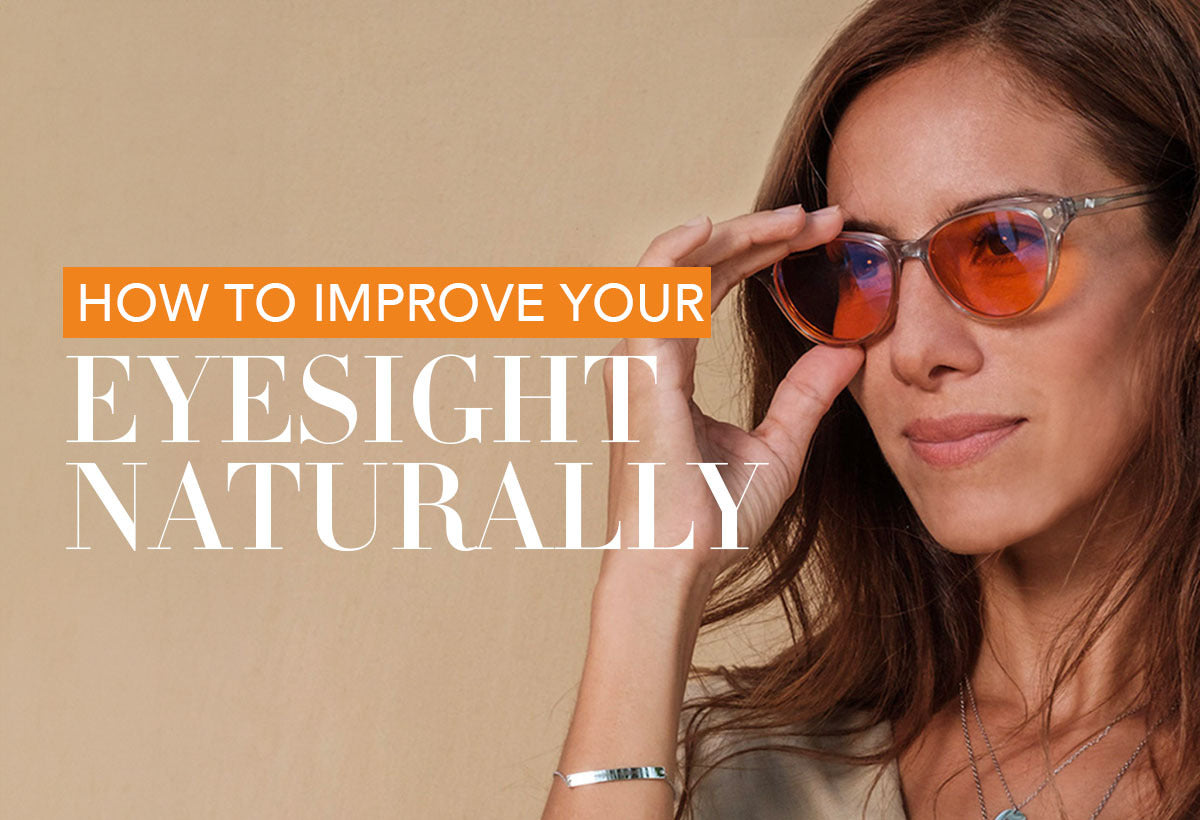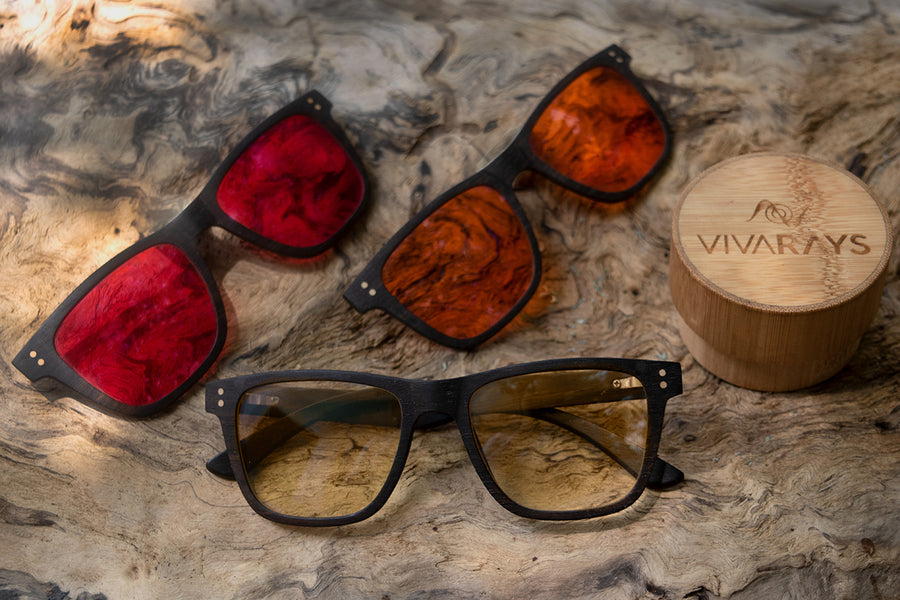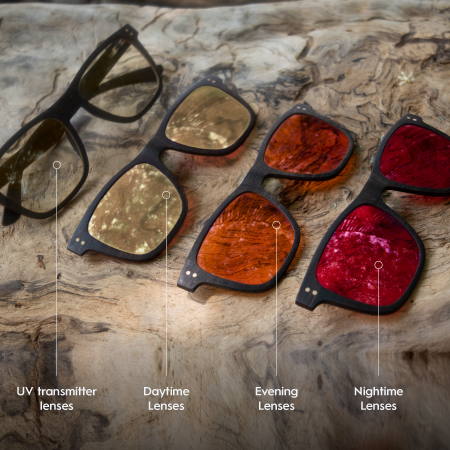HOW TO IMPROVE YOUR EYESIGHT NATURALLY

Good day Viva community!
In todays post I want to help reduce the myths surrounding eyesight, and its deteriortion.
Like a lot of myths about our health and our true potential, most people believe that it is a normal part of aging to lose our eyesight, have to wear prescription glasses and eventually think about getting costly eye surgery for cataracts or another pathology.
But let me ask you this: Were we really designed to decay over time?
Or have we simply lost our way and wandered away from our natural and optimal environment, and into one that is geared towards expensive and sometimes unneccassary surgery?
We are now living in a world where our eyes are constantly under attack. During the last few years, and more than ever before, the pandemic had forced people to work indoors on screens and under a barrage of artificial light .This led to an increase in the prevalence of myopia by up to 3 times what it was in previous years. [1]
Our ancestors were exposed to natural sunlight all day and gathered around the fire at night. It was so much simpler and we did just fine.
How did that change?
We swapped nature’s rhythmic and balanced light with made-made artificial light from phones, TVs, overhead lights and a whole lot more. This disconnected us from the natural light and dark cycles that we were accustomed to, and its taken it's toll.
On occasion, we may experience that warm feeling we get when we watch the sun rise or set. A feeling of completeness and calm.
Can you relate to that feeling of inner joyousness and stillness while witnessing the magnificence of nature and it's many colors ?
Nature’s light which once was a daily meal that nourishes the soul, and the body, has now become an occasional event that we experience once in a while. If at all.
But could that be sabotaging our eye health, and overall wellbeing?

Our eyes absorb the full spectrum of sunlight, both visible including all the colors of the rainbow and invisible including infrared light and UV light.
The eyes are also designed to perceive the world in three dimensions, detect motion and gaze at near and distant objects while determining the distances between these objects.
This has changed drastically in our modern way of living. All we see is a blue-lit screen from a couple of inches away for most of our days and nights.
How is this major downgrade in the quality of the light that enters our eyes affecting our visual system and health?
THE VISUAL SYSTEM
Your eyes receive light beams, which are captured by the photoreceptors in the retina and transmitted into electrical impulses. These impulses then travel via the optic nerve to the visual cortex enabling you to see the world around you.
Yes, the eye is the most advanced camera that allows us to see the world around us. However, vision is only a small aspect to this light entering our eyes.
Light entering the eyes control and regulate the functioning of our nervous system, endocrine system and circadian system, and therefore the eye, which once thought of as a camera, is also a neuro-hormonal organ that controls the metabolism of every cell in your body
The master clock (SCN) controls your circadian rhythm via the light information that is transmitted from your environment, through the eye to synchronize your circadian rhythm with nature.
This is how your body knows the time of the day as well as the time of the season. As a result, the biological programming built into the brain uses this information to regulate sleep, wakefulness, growth, metabolism, mood, weight loss, detoxification etc.
Staring at screens all day and at night while being disconnected from the light and dark cycles will disrupt your ability to maintain an optimal circadian rhythm and to adapt to your environment. It literally makes you feel jet lagged all the time.
Can you relate to that terrible feeling you feel when you travel from one timezone to another?
Getting artificial lighting in your eyes at the wrong time of the day can literally confuse your body and brain into thinking that you’re in China while you’re physically living in the United states.
Eventually, your internal rhythm will break down leading to symptoms and diseases over time.

ANATOMY OF THE EYE
Here is a brief overview of its anatomy:
The cornea is a reflective surface that bends and slows light down. It contains a UV receptor called neuropsin which indicates to our nervous system that there is UV light present in our environment.
For example, UV light entering the eyes triggers the production of alpha- Melanocyte Stimulating Hormone (a-MSH) that keeps your appetite healthy and decreases your desire to eat.This makes it so much easier to control your food intake.
a-MSH also increases libido through the roof and increases melanin in the skin which makes you more attractive and tanned. It also increases melanin in the eye. This protects the eye from damage that is caused by oxidative stress.
When we expose our eyes to artificial light that peaks in blue light and lacks UV light, oxidative stress increases causing light toxicity and ocular inflammation.
The iris is the colored part of the eye that controls how much light enters the eye. It contains muscles that either dilate or constrict the pupil depending on the light intensity.
The lens is a natural crystal in the eye that reduces and filters the light that enters the eye. As it degenerates because of excessive artificial blue light that is not balanced and with the other frequencies of light, it becomes opaque and you develop cataracts. [2]
The vitreous body contains a clear liquid gel and a specific type of collagen that slows light down furthermore. Additionally, it has piezoelectric properties.
Now what does that mean?
This means that it can convert light into electricity that the brain understands to be a certain time of the day, at a certain time of the year
The choroid is the vascular layer of the eye. When the spectrum of light reaching the choroid changes because of prescription glasses, sunglasses, contacts or an unbalanced light exposition, its thickness changes. This then pushes the retina out of its original point creating problems with focus such as myopia or hyperopia.
The retina has multiple layers. The photoreceptors rods-cones and melanopsin detect light and dark and convey light information to the brain in order to synchronize the master clock in the brain to the solar time.
Melanopsin for example is very sensitive to blue light and much less sensitive to red light. The rods and the cones can also play a role in the circadian entrainment.
As a rule of thumb, we need a lot of bright light during the day, ideally sunlight, which contains a blend of blue light that is balanced with all the other frequencies of colors.
We also need to eliminate blue and green lights at night while dimming down the brightness. This allows us to be in sync with the light in nature and have optimal sleep, wakefulness and metabolism.
THE EYES & THE AUTONOMIC NERVOUS SYSTEM
The eye controls an important part of your autonomic nervous system called the paraventricular nucleus (PVN). The PVN controls the balance between your sympathetic (fight/flight/freeze) and parasympathetic (rest/digest/reproduce) response. It is particularly sensitive to the UV spectrum of light. [3]
The muscle that constricts the pupil is controlled by the parasympathetic nervous system while the muscle that dilates the pupil is controlled by the sympathetic nervous system.
Being exposed to UV light lowers blood pressure and makes you calm and less anxious. Essentially, it activates the parasympathetic nervous system.
Being under artificial lights that lack UV, makes it impossible for you to constrict your pupil, putting you even more at risk of blue light toxicity since even more blue light can get through.
Also, UV light triggers the release of beta-endorphin, a natural opioid that lowers pain and improves our mood. Nature designed us to be addicted to sunlight.
When sunlight touches the eye, it transforms a compound called POMC into dopamine, serotonin, melatonin as well as the hormone alpha-MSH. All of these molecules are responsible for your motivation, drive, mood, hunger/satiety, libido and overall well-being.
Do you see how your eyes are responsible for much more than your vision?
Now you know a little bit more about your eyes (keep in mind that ophthalmology is a 3 year residency program so there is a lot to know about them).
HOW YOU CAN MAINTAIN AND IMPROVE YOUR EYESIGHT
Here are a few simple steps you can take to get things back on track, and heal or improve your eyesight.
1. Expose Yourself To Healthy Light & Avoid Sunglasses
Were you born with clothes, sunscreen and sunglasses? No. You were born naked as nature intended. We are made to thrive in sunshine and this includes our eyes.
Full spectrum sunlight is our natural, optimal light environment. It allows you to create vitamin D which protects your eyes against macular degeneration and cataracts.
Sunglasses block infrared light and UV light from reaching your eyes. Both are responsible for important processes in the body.
If UV light cannot reach your retina, the brain doesn’t know that you are in an environment containing UV and thus it doesn’t activate its own protective mechanism in your skin, putting you at risk of sunburn and skin cancer.
2. Stop Fearing UV Light
Like everything in life, too much of a good thing can become problematic. The same thing goes for UV light. The small amount we get from nature, balanced by the rest of the natural spectrum of sunlight, is actually beneficial in many ways for us.
As Dr.John Ott says: '' Giving too much oxygen at birth will blind the baby, but it would be foolish to conclude that oxygen is bad and we should avoid it at all costs''.
There are hundreds of peer-reviewed studies about the beneficial effects of UV light on our health. Trace amounts of UV light, like we get from sunlight are essential to our health
We know that too much light into the eyes can be damaging. This is why your pupils have the ability to constrict or to dilate. Even if we don’t have the capacity to see UV light, there are special receptors in our eyes that can detect it.
These receptors send feedback to our brain to help control the constriction/dilatation of the pupils. So when you are outside wearing prescription glasses or sunglasses that block UV light, your pupils lose their ability to constrict properly.
After a while, your eyes become much more sensitive to sunlight because you don’t have the ability to properly constrict your pupils.
After a couple of days of gradually increasing your exposure to natural sunlight, your pupils will regain their ability to constrict in response to sunlight and your eyes will be able to tolerate natural sunlight as they should.
3. Improve Your Photobiomodulation
Red and infrared light have been shown in multiple studies to be safe and effective for eye health. Studies using either red light, near infrared light or a combination of both have demonstrated significant improvements in vision, inflammation and healing.
Both red and infrared light acts on our mitochondria, the engine of our cells responsible for the transformation of foods & light into energy. We are only starting to understand the benefits these wavelengths have on sleep, skin health, hormone, vision and overall health.
You can get access to these healing wavelengths via photobiomodulation devices or simply by going outside in the sun!
Who said it had to be hard or expensive?
4. Optimize Your Sleep
During sleep your brain volume shrinks to allow the glymphatic system to work at full capacity. The glymphatic system is responsible for the renewal of cerebrospinal fluid, the liquid surrounding every nervous tissue in your body as well as the clearance of metabolic waste from your neurons.
This includes your optic nerve. An optimal clean-up is essential every night to maintain a healthy visual system.
Make sure to sleep in a dark cave. The general rule is if you can see your hand, it’s not dark enough. Blackout face masks are a good idea for traveling as well as if you don’t have blackout curtains at home
5. Avoid Blue Light/Artificial Light
Artificial light from our screens or LED bulbs is composed mainly of a narrow peak in blue light and contains no UV or infrared light. Blue light has short wavelengths, which causes light to scatter more easily than other colors.
When looking at a computer screen or other digital devices that emit significant amounts of blue light, the scattering of light reduces contrast which leads to digital eye strain.
Since blue light has a higher index of refraction than the rest of visible light, it focuses in front of the retina which is why excess blue light exposure can lead to a condition called blue myopia.
Long exposure to an incomplete spectrum of light can lead to dry eyes, eye strain, loss of visual acuity, migraine and eventually macular degeneration.
Blue light has the ability to generate oxidative and thermal stress in the retina. This is why long periods of exposure to blue light unbalanced by the rest of the spectrum like in artificial light has been shown to accelerate the death of photoreceptors leading to poor vision.
One of the consequences of diabetes is diabetic retinopathy, a condition starting with mild vision problems and ultimately blindness. High insulin and blood glucose levels lead to poor blood flow in the retina which eventually causes blindness. How does that tie to artificial light?
When you are stimulated by high energy blue light all day, your stress hormone (cortisol) levels increase. Since cortisol is responsible for the proper regulation of blood sugar, over time blue light exposure will lead to high insulin and blood glucose levels even if you consume a low carb diet.

6. Make Nutritional Improvements
Make sure to get plenty of vitamin A, ideally from animal sources as it already comes in the active form retinol. It helps to maintain a clear cornea and allow us to see in low light conditions.
All the opsins (light receptors) in the body work with vitamin A.
Vitamin A is yellow. Blue light, of course, is blue. Yellow and blue are complementary colors – or a.k.a opposite colors. When opposite colors are mixed together they cancel each other out and become a grayscale color. Blue light is an antidote against Vitamin A.
Lutein and zeaxanthin are also part of the carotenoids family and are important to maintain the macula and retina healthy. They also help to filter excessive blue light thus protecting them from accelerated damage.
They have been shown to prevent cataracts as well as the progression of advanced macular degeneration.
The retina contains a high concentration of DHA. Omega 3s like DHA not only helps healthy retinal function but are also anti-inflammatory. They increase blood flow to the eye and support the production of tears for proper lubrication.
The retina contains more DHA in it than in any other part of the brain. DHA runs between our eyes and the central clock in the brain. It converts sunlight into electricity that the central clock uses to determine the time of the day.
DHA is continually reprocessed through the retinal pathway using the combination of vitamin A and incoming light, and therefore, artificial blue light destroys DHA in the eye, harms vision, and disrupts the central clock in the brain
Zinc is highly concentrated in the retina and the choroid. It helps to bring vitamin A from the liver to the retina to produce melanin, a protective pigment in the eyes. Zinc deficiency can lead to poor night vision and an increased risk of cataracts.
7. Avoid EMF
In addition to blue light toxicity, cataracts are usually caused by a glycation of the proteins in the lens of the eye. This process is driven by an enzyme that works with transition metals which are very reactive to electromagnetic fields in the radiofrequency(RF) range.
This is why studies have demonstrated that people who are exposed frequently to RF either at work or at home have an elevated risk for cataract formation.
8. Use Circadian lenses
Much more than just blue light blocking glasses, you need a pair of circadian lenses. Every time you are exposed to artificial light or screens, put your circadian lenses on.
Depending on the time of day, you don’t want to wear the same type of lenses. You want to mimic as much as possible what sunlight would give you. That’s why our Vivarays Clip’N’Go comes with three different lenses all corresponding to a specific time of day.
If you wear prescription glasses, check out our UV transmitter lenses. They use a special technology that allows UV through so that you still get the benefits from UV light when you are outside instead of it being completely blocked by your glasses.
Lastly, when looking at screens, take breaks and do the 20-20-20. Look for 20 seconds at something 20 feet from you and then move to the forest for 20 years… Just kidding. But take breaks and look for 20 seconds at something 20 feet away every 20 minutes. This will allow your eyes to relax.
Despite what is commonly believed in mainstream medicine, your eyesight is not doomed. Like the rest of your body, your eyes can heal and recover when the proper conditions are met.
IN SHORT, AND SIMPLY PUT: Expose yourself to sunlight on a daily basis, avoid junk light (from phones, TVs, artificial lighting and elsewhere), get the appropriate sleep and nutrition and let your body do the rest.




A wonderful day to you Phaedra! And I trust you are doing well 🤗
We understand the hesitation on your Lasik surgery, and we’d love to refer you to Dr. Valerie, the optometrist we deeply trust and who has exceptional expertise in the science of light and quantum health. Kindly fill out this intake form for the 1 on 1 session with her: <https://forms.gle/ZiLVJFuD6ntHPXSi6>
Looking forward to the positive outcomes of your session with Dr. Valerie. 💛🧡❤️
I have worn prescription lenses since I was in 6th grade. I was thinking about getting eye surgery – lasik or the like – so I don't have to wear glasses, but I'm concerned that the surgery would inhibit my eye's ability to let full spectrum light in. Can you tell me what the surgery after effects regarding light would be?
Thank you again for your thoughtful feedback and I really appreciate your clarity and precision Debbie!
You’re absolutely right that in pigment-based color theory (like in painting), yellow and blue are primary colors and mix to make green, and that orange is the true complementary color to blue. That’s spot-on for pigment interaction, and it’s a helpful distinction to make.
What I was referring to, though, was light-based color theory , specifically the additive RGB model, which applies to light, screens, and optics. In that framework:
Yellow is created by red + green light
And blue is directly opposite yellow on the color wheel
So in light and digital color terms, blue and yellow are considered complementary which is where that wording came from.
As for the vitamin A comment, thank you again for catching the confusion. What I meant to say is:
Blue light actually degrades vitamin A,
because vitamin A is a yellow, fat-soluble compound , and blue light cancels or breaks down yellow pigments on a photochemical level.
So rather than vitamin A being the “antidote” to blue light, it’s the opposite: blue light can deplete vitamin A , especially with overexposure at night.
Thank you again for your sharp eye and for holding the conversation to a high standard.
So happy to hear this Blessing! It’s not an easy journey for sure but you are in the right track! So excited to see your transformation in your health and wellness journey 💛🧡❤️
You’re most welcome Dr. Stevens! We’ll do our best to share more for sure. Together, let’s spread healthy light! 💛🧡❤️
Leave a comment